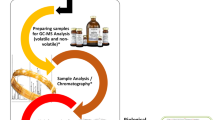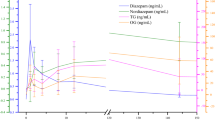Abstract
The aim of our study was to employ a liquid chromatography coupled with electrospray ionization multistage tandem mass spectrometry (LC-ESI-MSn) method for the identification of the major components of Resina Draconis extract (RDE) and their metabolites in rat urine. Based on the above, 18 compounds were tentatively identified from the RDE. Among them, 4 compounds were unambiguously characterized by the comparison of the retention time and mass spectra with those of reference compounds and 14 compounds were tentatively identified by comparing the mass spectra with those of literature. In vivo, 21 compounds, including 13 parent compounds and 8 metabolites, were detected in rat urine after oral administration of RDE. The results may be helpful for future research on traditional Chinese medicine.





Similar content being viewed by others
References
Zheng QG, Chen JT, Zhang YJ, Yang CR (2005) The chemical constituents and pharmaceutical activities of Dragon’s blood, a famous traditional medicinal herb. Nat Prod Res Dev 17(Suppl):84–95
Choy C, Hu C, Chiu W, Wang T (2008) Suppression of lipopolysaccharide-induced of inducible nitric oxide synthase and cyclooxy -genase-2 by Sanguis Draconis, a dragon’s blood resin, in RAW 264.7 cells. J Ethnopharmacol 115:455–462
Deepika G, Bruce B, Rajinder KG (2008) Dragon’s blood: botany, chemistry and therapeutic uses. J Ethnopharmacol 115:361–380
Paul B, Masih I, Deopujari J, Charpentier C (1999) Occurrence of resveratrol and pterostilbene in age-old darakchasava, an ayurvedic medicine from India. J Ethnopharmacol 68:71–76
Cichocki M, Paluszczak J, Szaefer H, Piechowiak A, Rimando AM, Baer-Dubowska W (2008) Pterostilbene is equally potent as resveratrol in inhibiting 12-O-tetradecanoylphorbol-13-acetate activated NFkB, AP-1, COX-2, and iNO S in mouse epidermis. Mol Nutr Food Res 52(Suppl. 1):S62–S70
Frankel EN, Waterhouse AL, Kinsella JE (1993) Inhibition of human LDL oxidation by resveratrol. Lancet 341:1103–1104
Zhang YS, Li YZ, Chen B, Deng YL, Li YJ (2011) Simultaneous quantification of loureirin A and loureirin B in rat urine, feces, and bile by HPLC-MS/MS method and its application to excretion study. Anal Bioanal Chem 400:1181–1187
Fan LL, Tu PF, Chen HB, Cai SQ (2009) Simultaneous quantification of five major constituents in stems of Dracaena plants and related medicinal preparations from China and Vietnam by HPLC-DAD. Biomed Chromatogr 23:1191–1200
Chen X, Yong K, Lv JC, Zhang TB (2009) Analysis on migrating constituents absorbed into blood of mice after i.g. administration of Resina Draconis. Zhongcaoyao 40:352–355
Wang DG, Hang TJ, Wu CY, Liu WY (2005) Identification of the major metabolites of resveratrol in rat urine by HPLC-MS/MS. J Chromatogr B 829:97–106
Shao X, Chen XX, Badmaev V, Ho CT, Sang SM (2010) Structural identification of mouse urinary metabolites of pterostillbene using liquid chromatography/tandem mass spectrometry. Rapid Commun Mass Spectrom 24:1770–1778
Fabio M, Leonardo DD, Hicham B, Bartolo G, Anna N, Giovanni S (2010) The assay of pterostilbene in spiked matrices by liquid chromatography tandem mass spectrometry and isotope dilution method. J Mass Spectrom 45:358–363
Wei H, Wen DX, Liu XS, Tang RJ (1998) Constituents in petroleum ether and ethyl acetate extract fractions of Dracaena cochinensis (Lour.) S.C.Chen. China J Chin Mater Med 23:616–619
Lu WJ, Wang X, Chen J, Lu Y, Wu N, Kang W, Zheng Q (1998) Studies on the chemical constituents of chloroform extract of Dracaena cochinchinensis. Acta Pharm Sinica 33:755–758
Zhou ZH, Wang JL, Yang ZR (2001) Cochinchinenin-a new chalcone dimer from the Chinese dragon blood. Acta Pharm Sinica 36:200–204
Duangdeun M, Geoffrey AC (1988) Retrodihydrochalcones from Dracaena Loureiri. J Nat Prod 51:1129–1135
Zhou ZH, Wang JL, Yang ZR (2001) Chemical constituents of Sanguis Draxonis made in China. Zhongcaoyao 32:484–486
Tu PF, Tao J, Hu YQ, Zhao MB (2003) Flavones from the Wood Dracaena cochinchinensis. Zhongguo Tianran Yaowu 1:27–29
Zheng QA, Li HZ, Zhang YJ, Yang CR (2004) Flavonoids from the Resin of Dracaena cochinchinensis. Helv Chim Acta 87:1167–1171
Zhu YD, Zhang P, Yu Haiping, Li J (2007) Anti-Helicobacter pylori and Thrombin Inhibitory Components from Chinese Dragon’s Blood, Dracaena cochinchinensis. J Nat Prod 70:1570–1577
Wang JL, Li XC, Jiang DF, Ma P, Yang ZR (1995) Chemical constituents of Dragon’s Blood Resin from Dracaena cochinchinensis in Yunnan and their antifungal activity. Yunnan Zhiwu Yanjiu 17:336–340
He L, Wang ZH, Li HM, He LX (2003) Chemical constituents from resin of Dracaena cochinchinensis (II). China J Chin Mater Med 28:1195
Zhou ZH, Wang JL, Yang ZR (1999) Three Glycosides from the Chinese Dragon’s Blood (Dracaena cochinchinensis). Zhongcaoyao 30:801–804
Qiao X, Han J, Xu M, Zhang ZC, Ye M, Ye G, Guo DA (2011) Metabolic profiling of GuanXin II prescription based on metabolic fingerprinting and chemical analysis. J Pharm Biomed Anal 54:789–798
Acknowledgments
The subject was supported by the National Science and Technology Major Project “Key New Drug Creation and Manufacturing Program”, China (nos. 2012ZX09301001-001 and 2011ZX09201-201-20).
Author information
Authors and Affiliations
Corresponding authors
Rights and permissions
About this article
Cite this article
Liu, F., Wu, B., Xiao, W. et al. Identification of the Major Components of Resina Draconis Extract and Their Metabolites in Rat Urine by LC-ESI-MSn . Chromatographia 76, 1131–1139 (2013). https://doi.org/10.1007/s10337-013-2473-z
Received:
Revised:
Accepted:
Published:
Issue Date:
DOI: https://doi.org/10.1007/s10337-013-2473-z




